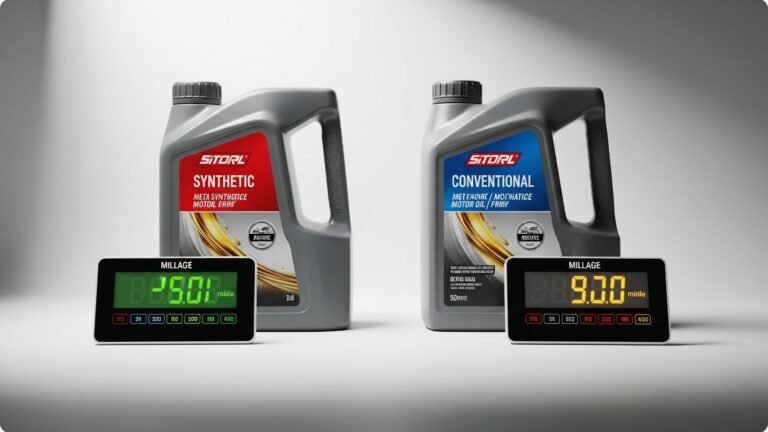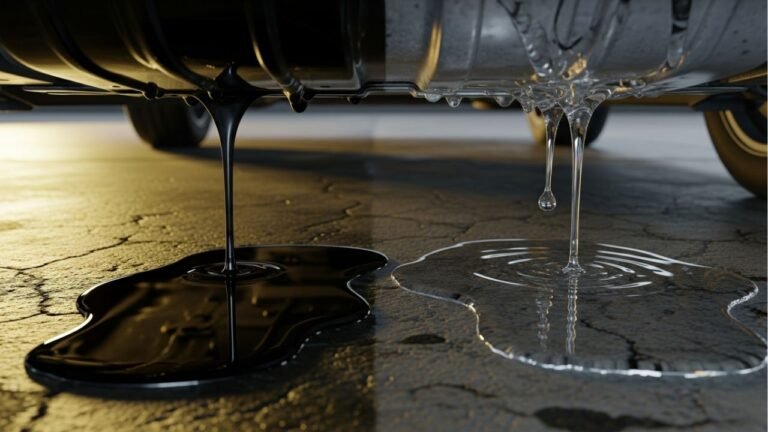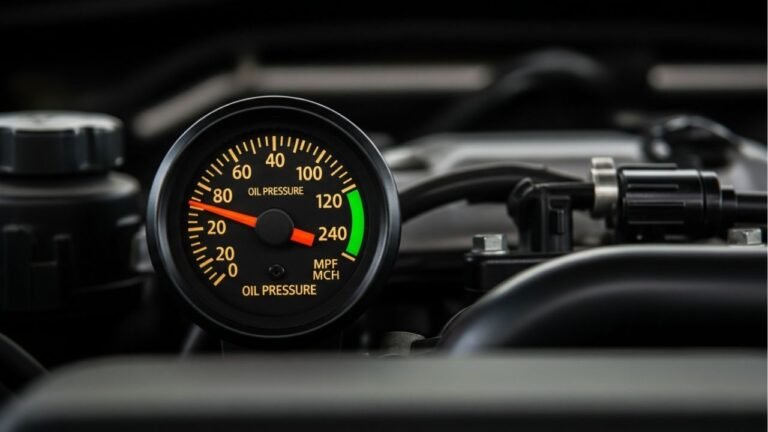What Happens If You Put the Wrong Oil in Your Car?

Ever changed your car’s oil in a hurry? Maybe grabbed a bottle that “looked right,” poured it in, and drove off—no big deal, right?
That’s exactly what happened to me a few years ago. I used 10W-30 in my car when it needed 5W-20. I figured, “Oil is oil.” But soon, my engine started making weird noises. The check engine light popped up like it was tattling on me.
So, what happens if you put the wrong oil in car?
Turns out, a small mistake like that can snowball into expensive repairs. Whether you’re a first-time car owner or someone who’s changed oil dozens of times, this guide will help you avoid a costly mess.
Let’s break it down so it’s easy to follow—even if you’re not a gearhead. We’ll use relatable stories, bite-sized info, and expert advice to get you up to speed.
In This Article
- 1 The Role of Oil: Your Engine’s Lifeline
- 2 Real-Life Story: My Costly Mistake
- 3 What To Do If You Already Used the Wrong Oil
- 4 How Mechanics Diagnose Wrong Oil Usage
- 5 DIY Oil Change? Tips to Avoid the Mistake Again
- 6 How Different Cars React to Wrong Oil
- 7 Preventive Maintenance: Your Oil Routine
- 8 FAQs: Quick Answers for Curious Drivers
- 9 Conclusion: One Small Detail, Big Impact
The Role of Oil: Your Engine’s Lifeline
Think of oil as your engine’s blood. It circulates through the system, cooling, cleaning, and lubricating every moving part.
Without it? Your engine is toast.
Now imagine using the wrong type of blood—thicker, thinner, not made for your system. That’s what happens when you use the wrong oil.
Motor oil does four main things:
-
Lubricates metal parts to reduce friction
-
Cools the engine by transferring heat
-
Cleans by picking up dirt and grime
-
Seals microscopic gaps to boost efficiency
Each car is designed for a specific oil viscosity and type. Ignoring that is like putting diesel in a gasoline engine—just because it’s fuel doesn’t mean it’ll work.
How to Know If You’ve Used the Wrong Oil
You won’t always see smoke or hear banging when you use the wrong oil. Sometimes, the symptoms are subtle. Here are a few signs to watch for:
-
Engine sounds rough or louder than usual
-
Oil warning light turns on
-
Slow acceleration or poor fuel economy
-
Car struggles in cold or hot weather
-
Unusual ticking or knocking noises
I ignored these signs at first. I blamed the weather, the gas, even the road. But the culprit was the oil I used.
Types of Oil and Why They Matter
You’ve probably seen labels like 5W-30, 10W-40, or 0W-20 and thought, “Why all the numbers?”
Let’s decode that.
-
The “W” stands for Winter.
-
The number before “W” shows how the oil flows in cold temperatures.
-
The number after “W” tells you how it flows when the engine is hot.
So, 5W-20 flows better in cold starts and thinner when hot, while 10W-40 is thicker overall.
Choosing the wrong one throws your car off balance. A thin oil might not protect the engine on a hot day. A thick one might not reach the engine fast enough on a cold morning.
Here’s a quick table to help:
| Oil Type | Best for Climate | Common Usage | Risk When Used Incorrectly |
|---|---|---|---|
| 0W-20 | Very Cold | Hybrids, modern engines | May be too thin in hot climates |
| 5W-30 | Mild to Hot | Sedans, small SUVs | Sludge buildup if engine prefers thinner oil |
| 10W-40 | Hot, Older Engines | Trucks, older vehicles | Slow start-up in winter |
| 15W-50 | Very Hot | Performance, racing | Overloads normal engines |
What Happens If You Put the Wrong Oil in Car?
Now for the big question: What happens if you put the wrong oil in car?
Let’s explore what really goes on inside your engine when the oil isn’t right:
1. Poor Lubrication = Increased Wear
Using oil that’s too thick or too thin can mess with lubrication. The engine parts grind more, and friction heats things up fast. It’s like running without socks—blisters form before you know it.
Soon, components like pistons, valves, and bearings wear out quicker than they should.
Over time, you could need:
-
New piston rings
-
Valve replacements
-
Even a full engine rebuild
Not cheap. Not fun.
2. Engine Overheating and Stress
Wrong oil can’t handle the heat. Literally.
Thicker oil might clog narrow oil passages, while thinner oil might vaporize when it gets too hot. Either way, your cooling system struggles to keep up.
It’s like putting the wrong type of coolant in a radiator—it just can’t do the job.
In my case, my engine temp needle flirted with red for weeks before I figured it out. That added months of wear in just days.
3. Fuel Economy Drops
When the engine works harder to pump the wrong oil, it uses more fuel. You’ll notice fewer kilometers or miles per liter. Think of it like riding a bike with a flat tire—more effort, less distance.
Even a 5% fuel drop adds up over time, especially with fuel prices these days.
4. Startup Problems in Cold or Hot Weather
Ever tried to pour honey in winter? That’s what thick oil does when it’s freezing out—it doesn’t move. Your engine starves for lubrication in the first few seconds.
And those few seconds are critical.
In hot weather, oil that’s too thin becomes like water. It slips past seals, evaporates, and can lead to low oil pressure. Eventually, you’ll get oil leaks or engine knock.
5. Warranty Might Be Voided
If your car is under warranty, using the wrong oil can void it.
Manufacturers have very specific oil requirements for a reason. If something breaks and the dealership finds out the wrong oil was used, they might not cover the repair.
That can be thousands of dollars out of pocket.
Real-Life Story: My Costly Mistake
Let me get personal here.
A few years ago, I was driving an old Toyota. I figured since it was “just an old car,” I didn’t need to follow the manual. I used 10W-40 instead of the recommended 5W-30. No big deal, right?
Wrong.
A week later, my engine was stalling on cold mornings. Then came the overheating. Then came the ticking noise—like a metronome of regret.
The mechanic said, “Who changed your oil?” I said, “I did.” He looked at me, shook his head, and handed me a $900 repair bill.
Lesson learned: Always use the right oil.
What To Do If You Already Used the Wrong Oil
Okay, so you’ve realized it: you used the wrong oil. Maybe you panicked. Maybe you’re reading this after seeing smoke or a warning light. Don’t worry—it’s not always a death sentence for your engine.
Here’s what you can do:
-
Don’t drive further. Stop the car if you’re seeing any warning signs or unusual behavior.
-
Check the oil level and viscosity on the dipstick. If it’s too thick or too thin, don’t ignore it.
-
Schedule an oil change immediately. A complete flush and fresh oil (the correct one this time) can undo some damage if done early.
-
Replace the oil filter too. It may be holding contaminated or unsuitable oil.
-
Monitor your engine after the change. Listen for strange noises and check for leaks.
-
Consult a mechanic if things still feel off. Better safe than stranded.
Act quickly, and you can avoid serious damage. Delay, and the problem only gets worse.
How Mechanics Diagnose Wrong Oil Usage
Ever wondered how mechanics know you used the wrong oil? It’s not magic—it’s experience and a few diagnostic tricks.
Here’s how they can tell:
-
Oil texture and smell: Too thick or burnt? That’s a red flag.
-
Oil pressure readings: Wrong viscosity affects oil pressure—either too high or too low.
-
Cold start behavior: Engines struggle or stall when the wrong oil is in play.
-
Wear signs in used oil: Mechanics may check for metal shavings or sludge buildup.
A good mechanic can tell within minutes if the oil is off. Some may even test it chemically to see if it matches manufacturer specs—especially under warranty situations.
DIY Oil Change? Tips to Avoid the Mistake Again
If you’re like me and prefer changing your oil at home (it saves time and money), then double-checking the oil type is key.
Here are some foolproof ways to get it right:
-
Read the owner’s manual. It will clearly state what oil your car needs.
-
Look at the oil cap. Some engines have the oil weight printed right there.
-
Avoid expired or dusty oil bottles. That’s how I once picked up the wrong one.
-
Use trusted brands. They usually label viscosities clearly and color-code caps.
-
Check climate compatibility. In hot or cold countries, the right oil weight matters even more.
I now keep a sticky note in my garage that says: “Toyota – 5W-30 only!” That simple trick has saved me twice.
How Different Cars React to Wrong Oil
Not all cars respond the same way to wrong oil.
Here’s a quick breakdown of how some vehicles might react:
| Vehicle Type | Wrong Oil Effect | Severity |
|---|---|---|
| Compact Sedans | Sluggish, poor fuel economy | Moderate |
| Turbocharged Engines | Oil breakdown, overheating | High |
| Older Engines (pre-2000) | Ticking, oil leaks | Moderate-High |
| Hybrids & EVs | Complex systems fail or log errors | High |
| Diesel Engines | Emission system issues, engine knock | Very High |
Modern engines are more sensitive to oil differences because they’re built tighter and rely on precision lubrication. Older engines, though a bit more forgiving, still don’t like being mismatched.
Preventive Maintenance: Your Oil Routine
Keeping your engine happy means staying on top of oil changes. Here’s my personal routine that you can use:
-
Every 3,000 to 5,000 miles (or 5,000–8,000 km): change oil.
-
Every change: check filter and swap it.
-
Before long trips: check oil level and clarity.
-
Every few weeks: do a quick driveway dipstick check.
-
Once a year: have a pro inspect the system.
It sounds like a lot, but it only takes a few minutes—and it saves thousands down the road.
FAQs: Quick Answers for Curious Drivers
1. Can using the wrong oil just once ruin my engine?
Not usually, if you catch it fast. But long-term use or ignoring symptoms can cause serious wear or failure.
2. What’s worse—too thick or too thin oil?
Both are bad, but too thin oil is especially dangerous in hot weather. It won’t protect the engine well.
3. Will a mechanic know if I used the wrong oil?
Yes. They can tell by oil pressure, texture, smell, and even chemical analysis in serious cases.
4. Can I mix oils if I run low?
Only in an emergency. Mixing viscosities or brands can change performance. Always top up with the same type if possible.
5. Is synthetic oil better for all cars?
Not always. Some engines are built for conventional oil. Synthetic is better in extreme temperatures or high-performance engines.
6. Why does oil weight matter so much?
Oil weight controls how well the oil flows at different temperatures. The wrong weight leads to poor lubrication, pressure drops, and overheating.
7. What should I do if I already drove 500 miles with the wrong oil?
Get an oil change immediately. The sooner you correct it, the less damage you risk.
8. Does climate really affect oil performance?
Absolutely. Cold weather needs thinner oil for startup. Hot climates need thicker oil to stay stable.
Conclusion: One Small Detail, Big Impact
It’s easy to dismiss oil type as a minor detail. But as we’ve seen, what happens if you put the wrong oil in car isn’t just a mild inconvenience—it can spiral into engine failure, expensive repairs, and reduced performance.
The good news? This is 100% preventable.
Treat your car’s oil like you’d treat your own health. Read the labels. Double-check the manual. And when in doubt, ask someone or Google it. Because your engine deserves better than a random oil gamble.
Take it from someone who learned the hard way—oil mistakes are easy to make, but easier to avoid.






